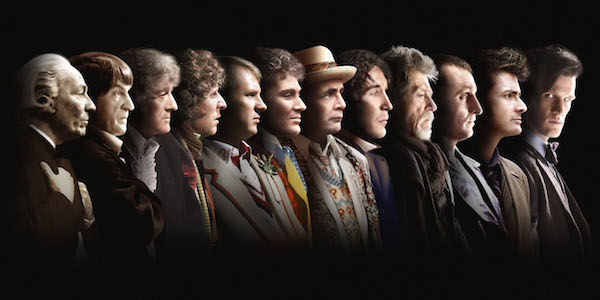Doctor Who's Regeneration Will Be A Christmas Miracle Because It's Impossible

When it comes to television, no show is more obsessed with rules and order than BBC’s iconic space-and-time traveling series, Doctor Who, the tale of a humanoid alien (also known as a Timelord) who flits about the universe and its history via a TARDIS (that’s short for time and relative dimension in space) disguised as a big blue police box. He cheats death every so often thanks to a process called regeneration — up to twelve times, meaning we get a maximum of thirteen faces. But like all things that outlive the rules that govern them, sometimes things have to change, and for Doctor Who, we are upon its hour of justification: because there’s a new Doctor coming to town during the Christmas Special, “The Time of The Doctor,” but that shouldn’t be possible.
**It goes without saying but: major spoilers ahead if you haven't watched the past season of Doctor Who.**
See, according to lore, the Doctor has regenerated as many times as is allowed by Gallifreyan rule (yes, showrunner Steven Moffat has confirmed that the War Doctor and the meta-crisis version of Ten both count as regenerations): twelve. So, technically, the Doctor should die with the end of Matt Smith. But we know he’s not, because Peter Capaldi is set to helm the TARDIS for the upcoming eighth season. But as we've previously speculated, this year's Christmas special is going to throw the old rulebook out of the window and get into the timey-wimey nuts and bolts of it all.
Leave it to Moffat to run head first into the unknown with the intent of changing things up (I mean, it is sort of his bag). Because regeneration, like much of the Whoniverse, is neither set in stone nor fully explained. And though we know it is biological change on the molecular level, regeneration changes the cells of a Timelord with unknown ramifications, outside of it resulting in the typically-human-like male we've encountered thus far. Made possible by the their triple-helix DNA (developed over billions of years of exposure to time travel/the untempered schism), the regenerated Timelord continues his or her existence with the same memories, just wrapped up in a spiffy new body and personality to boot.
But as Moffat explained it: “The face is not set from birth. It’s not like he was always going to be one day Peter Capaldi. We know that’s the case because in ‘The War Games’ he has a choice of faces. So we know it’s not set, so where does he get those faces from? They can’t just be randomly generated because they've got lines. They've aged. When he turns into Peter he’ll actually have lines on his face. So where did that face come from?” Which means there's a heck of a lot of wiggle room in there.
Of course, adding a wrinkle in all of this is Capaldi himself, who is no stranger to Doctor Who. In fact, we’ve seen his face before as Lucious Caecilius Iucundus, patriarch (and art collector, coincidentally enough) of the family saved by the Doctor in the Tennant-era story, “The Fires of Pompeii,” in addition to the role of John Frobisher in Torchwood: Children of Earth. Previously, Moffat has stated that Peter Capaldi’s Doctor will reference the fact that we have seen this face before. Which won’t be the first time familiar faces collide: just look at the inclusion of the Curator character during “The Day of The Doctor,” played by the Fourth Doctor, Tom Baker.
Checking back in with that Nerd Cubed interview, though, Moffat clued us all in on a conversation he had with former showrunner Russell T. Davies that suggests through re-casting Capaldi, the origins of these faces might be explained. “I remember Russell told me that he had a big old plan as to why there were two Peter Capaldi’s in the Who universe: one in Pompeii and one in Torchwood. When I cast Peter and Russell got in touch to say how pleased he was, I said, ‘Okay, what was your theory and does it still work?” and he said, ‘Yes it does. Here it is…’”
Your Daily Blend of Entertainment News
So how is that possible? Especially taking into consideration the fact that the Doctor "never forget[s] a face"? He couldn't just be an old, pre-William Hartnell Doctor, could he? Baker's response to Smith may contain the clues: “I know you don’t. And in years to come you might find yourself revisiting a few, but just the old favorites, eh?” Of course, this quote itself is purposefully vague and left up to interpretation, but it helps to look at it outside of the obvious: what if “old favorites” are actually old memories or acquaintances, rather than Doctors of the past that must be visited again? What if therein lies the answer: that the Doctor's regenerated lives are not his own. If you look at the doings in “The Rings of Akhaten,” the hazy picture all a tiny bit clearer. Clara defeated the planet-sized god/monster by feeding it the infinitesimal leaf, holding onto all the potential life her mother never had. This energy looked an awful lot like regeneration energy — to say nothing of the parallels between this old god, Grandfather, and the Doctor — leading us to assume that perhaps the transitive nature of Clara’s gift was a way to not only explain the god-monster, but in turn allude to the machinations behind Timelord regeneration.
Which was also bandied about in “The Night of The Doctor” when the Sisterhood of Karn explain the pinpointed accuracy with which the regenerative process can take place: gender, brawn, brains — all of it able to be hand-selected by the Timelord as he so chooses it.
So taking those two aspects in mind — that one’s life can be extended via the transference of potential, and that regeneration has evolved in a self-directed fashion — a clearer picture of the process is painted for the audience in a way that explains the existence of the Doctor outside of being The Doctor.
“If I were you, oh if I were you,” the Curator mused, “Perhaps I was you, of course. Or perhaps you are me… or perhaps it doesn’t matter either way. Who knows? Who knows.” This line is purposefully ambiguous, leaving plenty of headway for a Capaldi lead-in. Because while it might be easy to assume that the “old favorites” are old Doctors (especially considering that it is an old Doctor saying it), it might actually mean something else entirely: namely, a way to explain the recurrence of Capaldi even though we’ve seen his face before. Perhaps the Doctor's regenerative abilities come from his ability to live on borrowed time so to speak. To — much like the god-monster planet in "The Rings of Ahkaten" — gobble up the infinite potential these old favorites had in their memory, and from that transference, survive and thrive. In that way, being the Doctor is yet another way to fix the wrong that's inherent in his regenerative right to life upon life upon life.
Of course there’s still that pesky limit that needs to be taken care of, since it is canon that there are only twelve regenerative cycles. But with Gallifrey stuck in a pocket universe, lost in a moment of time, can the rule really be enforced? And what are the implications of further regenerations? There have been exceptions to the rule played out on screen (often via The Master), but the biologic and hierarchical ramifications of such a to-do are as-yet untold. Of course with current companion Clara at the helm — the Impossible Girl has always been the key to the Doctor escaping with his life in tact, throughout all of his history — one doesn’t have to look too far into the pool of hypotheticals to see the myriad of ways in which she may yet again change his future. Some might even call it a Christmas miracle.
